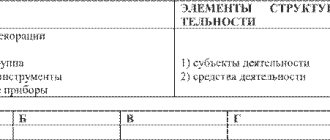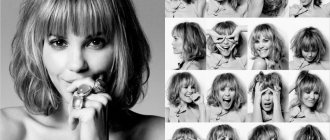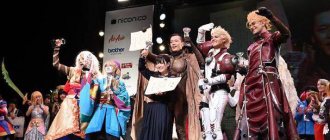People have many statuses and belong to many social groups, the prestige of which in society is not the same. A person looks at the world and treats other people in accordance with his status. The more social roles an individual is able to reproduce, the more adapted to life he is. Thus, the process of personality development often acts as the dynamics of mastering social roles.
A person interacts with different people and social groups every day. It rarely happens that he fully interacts only with members of one group, for example a family, but at the same time he can also be a member of a work collective, public organizations, etc. Entering simultaneously into many social groups, he occupies the corresponding position in each of them. position determined by relationships with other members of the group. To analyze the degree of inclusion of an individual in various groups, as well as the positions he occupies in each of them, the concepts of social status and social role are used.
Status (from Latin status - position, condition) - the position of a citizen.
Social status is usually defined as the position of an individual or group in a social system, which has characteristics specific to this system. Each social status has a certain prestige.
All social statuses can be divided into two main types: those that are prescribed to the individual by society or a group, regardless of his abilities and efforts, and those that the individual achieves through his own efforts.
What does the concept of social role include?
Social roles are characterized by dynamism. In other words, throughout one’s life a person tries on different social roles. A son or daughter must meet certain expectations, while other requirements are imposed on employees and mothers.
The structural content of the concept of social role consists of the following elements:
- behavioral reactions , his speech, actions, actions;
- The appearance of a person. Each social role has its own requirements in terms of appearance, and a person must meet them. The doctor should be in a robe, the policeman in uniform, the builder in a helmet;
- Human motivation. Members of a social group approve or disapprove of the behavioral reactions demonstrated by a person, and this also applies to his internal aspirations. The assessment of motives is carried out on the basis of the expectations of members of a social group, which are formed on the generally accepted understanding. If a girl who gets married aims to obtain material gain, then this behavior is condemned by society. If the source of her motivation is love and feelings, then society will positively perceive her actions.
Personality structure and its content
Like all significant systems of social life and all the laws of nature, a conscious person has his own personal structure. This structure is multi-level, and each level characterizes it in terms of different moral qualities of the individual:
- The biological level includes natural qualities of common origin (body structure, gender and age characteristics, temperament, etc.).
- The psychological level combines the psychological characteristics of the individual (feelings, will, memory, thinking).
- The social level consists of a specific lifestyle, communication style, well-founded beliefs, and social roles. This includes family, educational, ideological, financial, authoritative factors that reveal the moral qualities of an individual.
Each level reveals individual components of personal baggage as a whole. In addition to the level context, the personality structure is considered from the perspective of its constituent elements. These include:
- rationality – a person’s ability to think, develop, learn, acquire skills and competence;
- psycho-emotionality – a set of feelings, desires, impulses, motives and other factors opposed to rationality;
- worldview - the perception of the world and the determination of one’s attitude towards it by any representative of society: a man or a woman, an adult or a child, a realist or a mystic;
- orientation - the integration of character in a person’s ability to independently choose their values and life priorities;
- experience – skills, abilities, knowledge, habits accumulated over time, brought to automaticity, habits;
- abilities are perhaps the most important tool of a person, which determines his ability to perform useful activities;
- psychotype – protection of a person’s character, behavioral patterns and reaction to what is happening around him;
- temperament is a manifestation of a specific type of temperament, the energetic and dynamic component of the manifestation of brightness, speed, and strength of emotional response;
- body drawing - a person’s presentation of his outer shell from a favorable angle.
Examples of social roles
At the present stage of development of society, human life is characterized by diversity. A large number of life realities makes it possible to highlight many examples, indicating what society expects from a person in accordance with a certain social role:
- As part of their interaction with their parents, a son or daughter is expected to be obedient until adulthood and help in old age;
- A person crossing the road must follow traffic rules and not create a dangerous situation. The driver must also follow the prescribed rules to avoid an accident or a fine;
- A university student must attend lectures, pass sessions, undergo internships, assimilate and consolidate educational material, show respect to teachers during lectures and behave diligently while studying;
- The status of a friend implies providing a friend with help and support in difficult moments of life, defending and sharing his interests and worldview;
- A parent must take care of the child, satisfy his basic needs, monitor his health, implement an educational function, convey knowledge about the surrounding reality, and relay the norms accepted in society.
In the mechanism, each person can implement several social roles depending on the situation. Their distribution can be carried out either in a pre-established order, or they can arise unexpectedly, which is due to changed realities. After signing an employment contract, the boss expects the employee to follow and adhere to the specific rules set by the company. In turn, everyday phenomena force a person to become a participant in events that he did not plan to participate in at all.
Characteristic personality traits
The functions performed by a person predetermine the formation of his characteristic qualities. All of them are conventionally divided into internal and external.
Internal personality traits suggest a person’s spiritual wealth. These are the same qualities that are not visible to the eye, but are felt after communication. These include caring, participation, free-thinking, positive outlook, wisdom. In addition, internal traits include self-improvement, which involves constructive thinking, a responsible attitude towards everything, energy and determination, as well as a love of order.
External qualities of a person work to express his appearance. This includes artistry, attractive appearance, sense of style, beautiful, even speech, facial expressions and gestures.
Characteristics of the social role
Researcher Talcott Parsons, together with his colleagues, was able to systematize social roles in the middle of the last century. He identified five main characteristics of social roles:
- Emotional component. A number of roles, including physician, psychologist, social worker, require emotional restraint in situations where, in most cases, people show strong emotions, we are talking about illness, suffering, and death. Such strict requirements in terms of emotional restraint are not imposed on relatives or friends;
- Method of receipt. Some roles are the result of prescribed statuses. An example would be a child, teenager or adult - these are determined based on the person's age. Other roles must be earned or achieved, this may include the status of a qualified doctor, that is, to obtain it a person needs to invest time and effort, undergo training and practice;
- Scale. A number of roles are limited to strictly defined aspects of interaction between representatives of social groups. For example, the roles of the doctor and the patient are limited to issues related to the treatment of the disease or rehabilitation after surgery. A broader relationship is established between the child and his parents, when parents make efforts to ensure the child’s comfort in solving a wide range of issues;
- Formalization. Roles can be identified that emphasize interaction with people in accordance with established rules. For example, a library employee is engaged in issuing books for a strictly designated period, and demands a fine if the book is returned late. As part of other roles, special interactions are allowed with those with whom the person has formed personal relationships. For example, a person would not expect a brother, close friend, or parent to pay for any service rendered, but with a stranger payment would be a requirement;
- Motivation. Each role is based on its own motivational component. For example, if we are talking about an enterprising person, then people expect him to implement actions and actions aimed at making a profit. At the same time, a social worker, a striking example is a social work specialist, carries out his activities for the public good, while personal interests recede into the background.
According to researchers, each social role is a combination of all the characteristics described above.
Personality temperament
Very often in the practice of private psychology, testing methods are used. It applies to most problematic issues that arise in patients in the field of psychology. The test to determine personality type by temperament is no exception.
Temperament is a set of human properties that depend on his innate natural psychophysiological character traits. Temperament is considered in the context of those personality qualities that predetermine his type in terms of the characteristics of the activity of his mental system within the framework of intensity, speed, and tempo of psychological processes.
There are four types of temperament:
- phlegmatic - a person who is unhurried, unperturbed, has a stable aspiration and attitude, and does not show his emotions and feelings; phlegmatic people are calm and balanced, show tenacity and perseverance in their activities;
- choleric - hot-tempered, fast, passionate, but at the same time absolutely unbalanced, changes his mood through emotional outbursts, as a result of which he quickly becomes exhausted;
- a sanguine person is a person who leads an active lifestyle, characterized by liveliness, mobility, impressionability, quick reactions, frequent mood changes, an optimistic outlook on life and expressive facial expressions;
- melancholic - a person who is easily vulnerable, prone to constantly experiencing various events, overly impressionable, and little responsive to external factors.
Psychologically, a test to determine a personality type involves a number of specifically selected questions, the answers to which help to identify a person’s belonging to a particular type of temperament. Regardless of what kind of temperament a person has, each of its types has its own positive and negative sides, so there is no objective opinion about which type of temperament is the best among the others.
Types of social roles
There are several main classifications of social roles.
By type of social relations:
- Social roles associated with a person’s status and professional activities. Such roles are characterized by depersonalization and independence from the performer (student, driver);
- Social roles associated with interaction with people on an emotional level (idol, fan).
By type of social values:
- Represented social roles are the expectations of a person and members of his social group;
- Subjective social roles are a person’s ideas about his relationship to other people;
- The social roles played are behavioral attitudes that depend on a person’s position in society.
By type of role:
- Social roles prescribed by a public institution (woman - mother, daughter, wife, grandmother);
- Conventional social roles resulting from the adoption of social agreement on a voluntary basis (professional).
Communication function
From the point of view of the nature of the functions performed by a person, in addition to cognitive, affective and motor ones, it is common for him to perform communicative, educational, mental and social tasks.
The communicative function is the implementation of the exchange of information between people, during which people, through communication, share with each other their interests, feelings, emotions, and attitudes. Its influence on the development of personality is very important, since during mutual communication between people, a general understanding of the information received is developed, which is not only accepted by him, but also realized and thought through. That is why every communication process is accompanied by a unity of representation of activity, communication and cognition. And in it the communicative function is a fundamental component of public communications.
Difference from the concept of “social status”
Social status is the position that a person occupies in society. A social role is a set of actions that must be implemented by a person endowed with a certain status.
Based on this, we can conclude that status is a position, and a role is a model of behavior associated with status.
You can read more about social status in this article.
Educational personal function
No less important, along with the communicative function, is the function of education. It represents a huge contribution to the development of man as a mentally developed unit of society and is responsible for instilling in a person a certain baggage of moral qualities, formed feelings of duty and responsibility for his actions. The main task of the function of educating a personality is to model its specific type - temperament - one that would correspond to social morality for a specific period of historical time.
In modern psychology, the educational function is defined as humanistic, because in the process of education, the concepts of responsibility, morality, and compliance with one’s environment are instilled in a person. Its main goal is aimed at development, education, training and investment of knowledge in the head of every conscious citizen of society.
Mental function
Any cognitive process or act performed by a person is called a mental function of the individual. The psyche, as a specific property of the brain, predetermines the reflection of external phenomena through specifically performed processes of brain activity. Thus, there are several basic mental functions of the individual:
- perception represents information taken into account and is subsequently reflected in mental processes;
- thinking – a person’s ability to realize and think about specific thoughts;
- memory is the ability of the human brain to consolidate, store and reproduce information about the external world and its internal state for its further use;
- speech – a person’s ability to speak and share information with others;
- motivation is an incentive that gives a person an impetus to action;
- emotions – manifestations of feelings and psychological mood, state;
- consciousness – the ability to perceive what is happening around;
- will – the desire for stability and patience;
- attention is the ability to concentrate and react to the influence of external factors.
Natural
If we summarize all the synonymous meanings of this word, then its meaning can be briefly formulated as follows: essence is the main internal content of an object, which manifests itself in its external, visible forms and modes of existence.
You may be interested in: A teapot is... History and modernity
Anthropology is the science of the origin of man, the ways of his existence in the ecosystem, where he stands at the highest stage of development. Man is a biological object, and his natural essence is manifested in the fact that he, like other representatives of the animal world, has a body, needs for housing, sleep, food, and various innate instincts. It lives in almost all corners of the globe. Biology, physiology, and genetics study this natural object.










